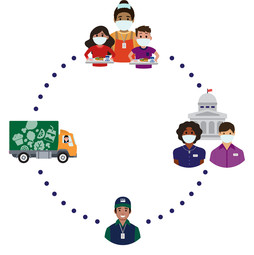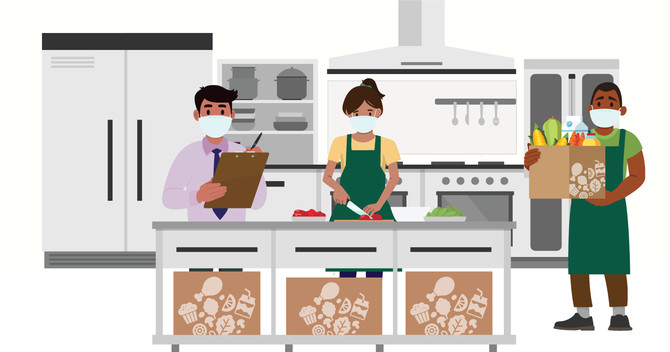USDA understands that many schools are experiencing supply chain issues during School Year 2021-2022. Some have received little notice that ordered food products will not be provided as planned. As a result, these schools have had to find other products to serve on the school meal menu. Schools can document how these substituted foods can meet the meal pattern requirements in a variety of ways, as shown below. |
|
 |
1. The Child Nutrition (CN) Label is one way of verifying the crediting of processed foods that include meats and meat alternates. The CN label on a food product shows how the product contributes toward food-based meal pattern requirements. While a CN labeled product may be available for products substituted by your distributor, they are less likely to be available for commercial products at retail stores. If your food product does not have a CN label, there are still other documentation options. These are discussed below.
2. The Food Buying Guide (FBG) can be used to document the specific contribution that a food makes towards the meal pattern. In the FBG, you can find items such as sliced apples (fruits), chopped broccoli (vegetables), breadsticks (grains), and black beans (meats/meat alternates). In addition to other meal components, you can use the FBG to show the crediting of these popular meats and meat alternates (no CN label required): meat, poultry, seafood, cheese, yogurt, soy yogurt, dry beans and peas, whole eggs, tofu, tempeh, peanut butter or other nut or seed butters, and nuts and seeds.
3. A Product Formulation Statement (PFS) from a food manufacturer or your vendor may be used to show how a food product credits toward meal pattern requirements. If possible, request a PFS for substitution products you may need to use in the future for menu items that may be more likely to experience supply chain issues in your area.
4. The Nutrition Facts Label and the ingredient list on retail-purchased food items provide information such as the serving size, nutrition information, and ingredients for the product. For some products, like breads or crackers, which can be matched to a description from the Grains section of the FBG, this might be all the documentation you need to show how the product contributes towards the meal pattern requirements.
5. Product Specifications provide the detailed standards of quality and wholesomeness by which the food item must be produced and processed. They may be used to document how the purchased foods contribute towards the meal pattern requirements. Specifications may include information on ingredients, nutrient standards, and meal pattern contribution for documentation purposes.
 Working Together to Address Supply Chain Issues
As always, work with your State agency to determine how best to provide documentation for your specific situation.
When there is a supply chain disruption due to COVID–19 with respect to foods served, USDA has granted a waiver of meal pattern fiscal action requirements in the National School Lunch Program (NSLP) and the School Breakfast Program (SBP), which extends to the NSLP Seamless Summer Option. Talk with your State agency if this is a concern for your school district.
As schools work toward resuming regular operations, USDA continues to offer flexibilities in response to public health needs and to ease administrative burden, while still promoting nutritious meals. Check out the Planning for a Dynamic School Environment website for information on the flexibilities and menu planning strategies.
Communicating with Families
Communication is key. Remember to communicate with parents and guardians about food substitutions as early as possible. Inform the community about the steps your district is taking to work through supply chain concerns in your area. Also, as substitutions are incorporated into the menu, remember to continue to read ingredient lists for allergen information. A customizable letter to families is available here.

 |
|
Do you have a success story to share? Share it on Twitter and tag @TeamNutrition. |
|